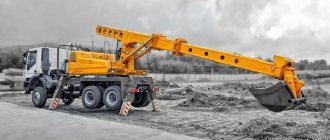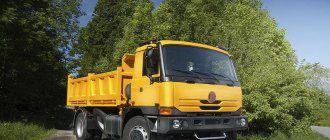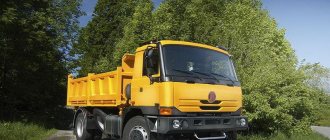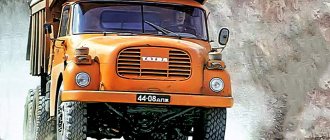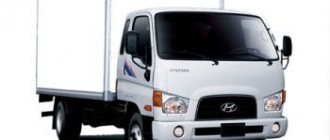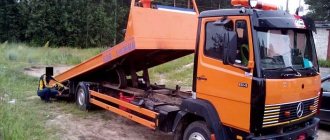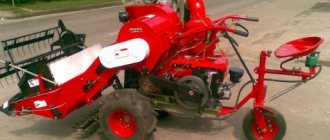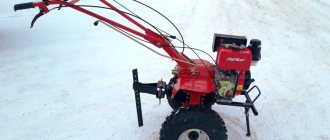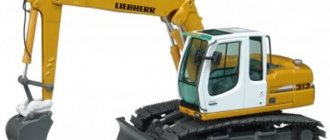History of creation
The confrontation between the Warsaw Pact countries and the United States influenced the growth of armaments. This created an urgent need for trucks. A lot of tanks and other armored vehicles were being assembled, but there was nothing to transport the platforms with them. Those left over from the Great Patriotic War and donated by the allies began to fall apart, there was no replacement. There was no point in hoping for help from the USSR, since the Union had a similar problem, and production was just beginning to improve.
The only state other than the Soviet Union that could afford the production of such trucks was Czechoslovakia. Work on the new project began in the early 60s at the plant in Kopřivnice.
The first experimental model “Tatra 813”, the photo of which shows it without a cab and body, was assembled in 1965. It was tested for 1.5 years, and only in 1967 did the first production model roll off the assembly line of the plant.
Excerpt describing Tatra 813
“And they took off the chain, you see, they went back,” they said, pointing across the shaft. “Mind your job,” the old non-commissioned officer shouted at them. “We’ve gone back, so it’s time to go back.” - And the non-commissioned officer, taking one of the soldiers by the shoulder, pushed him with his knee. There was laughter. - Roll towards the fifth gun! - they shouted from one side. “At once, more amicably, in the burlatsky style,” the cheerful cries of those changing the gun were heard. “Oh, I almost knocked off our master’s hat,” the red-faced joker laughed at Pierre, showing his teeth. “Eh, clumsy,” he added reproachfully to the cannonball that hit the wheel and the man’s leg. - Come on, you foxes! - another laughed at the bending militiamen entering the battery behind the wounded man. - Isn’t the porridge tasty? Oh, the crows, they slaughtered! - they shouted at the militia, who hesitated in front of the soldier with a severed leg. “That’s something, little guy,” they mimicked the men. – They don’t like passion. Pierre noticed how after each cannonball that hit, after each loss, the general revival flared up more and more. As if from an approaching thundercloud, more and more often, lighter and brighter, lightning of a hidden, flaring fire flashed on the faces of all these people (as if in rebuff to what was happening). Pierre did not look forward to the battlefield and was not interested in knowing what was happening there: he was completely absorbed in the contemplation of this increasingly flaring fire, which in the same way (he felt) was flaring up in his soul. At ten o'clock the infantry soldiers who were in front of the battery in the bushes and along the Kamenka River retreated. From the battery it was visible how they ran back past it, carrying the wounded on their guns. Some general with his retinue entered the mound and, after talking with the colonel, looked angrily at Pierre, went down again, ordering the infantry cover stationed behind the battery to lie down so as to be less exposed to shots. Following this, a drum and command shouts were heard in the ranks of the infantry, to the right of the battery, and from the battery it was visible how the ranks of the infantry moved forward. Pierre looked through the shaft. One face in particular caught his eye. It was an officer who, with a pale young face, walked backwards, carrying a lowered sword, and looked around uneasily. The rows of infantry soldiers disappeared into the smoke, and their prolonged screams and frequent gunfire could be heard. A few minutes later, crowds of wounded and stretchers passed from there. Shells began to hit the battery even more often. Several people lay uncleaned. The soldiers moved more busily and more animatedly around the guns. Nobody paid attention to Pierre anymore. Once or twice they shouted at him angrily for being on the road. The senior officer, with a frowning face, moved with large, fast steps from one gun to another. The young officer, flushed even more, commanded the soldiers even more diligently. The soldiers fired, turned, loaded, and did their job with tense panache. They bounced as they walked, as if on springs.
Forced diversity
The economy of Czechoslovakia at that time could not afford to use the power of the largest automobile plant to eliminate the needs of the army. This was the reason that even at the design stage, its design included the possibility of using the truck for civilian purposes.
"Tatra 813" 8x8 technical characteristics made it possible to produce it in several versions: six- and four-axle modifications. The intention to use the truck for peaceful purposes is also emphasized by the design of the cabin, which cannot be called military. The manufacturer assumed the possibility of producing models that could accommodate 3 or 4 people.
The truck was withdrawn from mass production only in 1982. The total number of models assembled was 11,751 units, while the capacity of the plant in Kopřivnice allowed the production of about 1,000 units per year.
This model was supplied to the Soviet Union in limited quantities. Only a few examples could be found on domestic roads:
- Three-axle Tatra 813TR 6x6.
- Flatbed trucks 8*8.
Production
Production of the Tatra T813 began in 1967 and was replaced by the Tatra T815 in 1982. Models were available with 4x4, 6x6 and 8x8 drives for civil and military use.
- Main models
- Crane 4x4
- Airport tug T813 6x6 with Tu-104
- T813 dump truck
- Fire 8x8
- KOLOS 8×8 with GAZ-63
- T813 RM70 grenade launcher chassis
- MLRS RM-70
- T813 6x6
- 152 mm SpGH DANA
Modifications for civil and official purposes
For peaceful purposes, the truck was used everywhere in various modifications. It was mainly found in the coal mining industry and as a transport for special services:
- Firefighters.
- Aviation tractors for transporting aircraft.
- Construction cranes.
- Rescuers.
- Ministry of Internal Affairs
The numerous advantages of the model were the reason that it was in operation for a long time. Although it was used extremely rarely. The reason for this was fuel consumption, amounting to 42 liters of diesel fuel per 100 km.
general description
The car received one of its unofficial names, “Octopus,” due to its unique technical characteristics.
Although it was built on the backbone frame familiar to the factory, the appearance of the model is completely new. Despite its impressive dimensions, the technical characteristics of the Tatra 813 allowed it to accelerate to 70 km/h, tow a trailer with a load weighing 100 tons on asphalt, and up to 12 tons on rough terrain.
The car had 8 driving wheels, 4 of which were steerable. As an approximate reference, the performance characteristics of the 8x8 model are given:
- Length – 8,800 mm.
- Width – 2,500 mm.
- Height – 2,750 mm.
- Ground clearance – 380 mm.
- Curb weight – 14 tons.
- Diesel engine – 17.64 l, 250 l/s, 12 cylinders.
- Gearbox – manual (20 forward, 4 reverse).
T 815-290S8T 42.300.8×8.1R/331
In this article we will talk about the Tatra T 815-290S8T 42.300.8×8.1R/331 truck. This vehicle is not 100% new in the production program, but only the product of another modernization of the famous Tatra T 815-290S8T 46.300.8x8.2R dump truck. At the same time, the task was set to increase the cross-country ability and “armor” of the units from below, as well as additionally carry out quite specific work in northern construction. The initiator of the development was the Russian Tatra dealer, the Avtotatik-M company, and the customer at the first stage was one of Gazprom’s subsidiaries.
The first difference between the cars was single-pitch tires on all axles 16.00R20, which made it possible to increase ground clearance and overall cross-country ability on weak-bearing soils. Unfortunately, due to the limited loading capacity of the rubber, the load on the rear bogie axle is limited to 13 tons (which is 15 tons for the previous S8T model), therefore the dump truck’s load capacity has decreased by 4.6 tons. At the same time, the S8T/331 turned out to be narrower: its width is 2500 mm, which is even 50 millimeters less than the S8T of the previous modification. The second difference is the body; it is an updated truck with “backward” unloading, a tailgate and underbody heating.
Manufacturer: Czech company “Porgest” (Novy Jicin), Hyva hydraulics, Hardox steel. Internal dimensions 6050x2300x1000 millimeters. The body is designed not only for transporting bulk cargo, but also, in accordance with the wishes of Siberians, for transporting road slabs. These are known to be used in the construction of roads, including technological ones, and during complete off-road conditions and in quarries. Moreover, according to the director of the representative office, initially the trucks wanted for these purposes something like a Tatra N9T truck tractor with a dump semi-trailer.
But, it seems, the maneuvering capabilities of such a road train exclude its use at standard northern construction sites. The scales tipped in favor of 8x8, and it looks like it turned out to be the perfect solution. By the way, the use of such a body necessitated an increase in the base by 700 millimeters compared to the S8T of the previous modification, but for the Tatra with its backbone frame this required replacing only two simple parts: a fragment of the backbone frame pipe and the drive shaft between the transfer case and the 3rd axle. Moreover, the wheelbase of 3300 millimeters is quite standard for the Terr No. 1 line if you recall, for example, the 221R84 chassis. For reasons beyond the control of the manufacturer, nine out of 10 S8T/331 vehicles of the first batch ended up not in the Yamal tundra, but among the hills and swamps of Yakutia. And not from the gas workers, but from the oil workers of AK Transneft. However, traditionally the Tatra truck doesn’t care what kind of dirt it kneads.
Technical characteristics Tatra T 815-290S8T 42.300.8×8.1R/331
Engine:
– Engine type – Euro-3; – Number of cylinders – 8; – Cylinder diameter/piston stroke – 120/140 millimeters; – Working volume – 12667 cm3; – Net power – 300 kW/1800 min-1; – Pure torque – 2100 Nm/1000 min-1.
Weight:
– Curb weight – 17800 kilograms;
– Load capacity – 24200 kilograms; – Maximum gross weight – 42,000 kilograms; – The maximum permissible load of the front axles is 2×8000 kilograms; – The maximum permissible load of the rear axles is 2×13000 kilograms. Dimensions:
– Width – 2500 millimeters; – Front track – 2074 millimeters; – Rear track – 2022 millimeters; – Ground clearance – 385 millimeters. Tires, wheels:
– Tires – 16.00 R20; – Discs – 20-10.00.
©. Photos taken from publicly available sources.
- Author: Evgeny Smolnikov
Rate this article:
- 5
- 4
- 3
- 2
- 1
(2 votes, average: 4.5 out of 5)
Share with your friends!
815
815 Arktik
Peculiarities
The created truck had many differences from its predecessors. The difference was not only in appearance - a futuristic cabin for that time and a large number of wheels.
Unique technical characteristics were hidden inside the model. During the design, many innovations were used that had never been used on Czech trucks:
- 4 independent brake systems of the Tatra 813, operating separately from each other, made it possible to reduce the time for a complete stop of a moving vehicle to a minimum.
- emergency, operating on the 2nd and 3rd bridges;
- manual, locking gearbox;
- auxiliary, closing the throttle valve and stopping the fuel supply;
- pneumatics, covering all axles and trailer.
A system for changing tire pressure was also installed, which increased cross-country ability, and a system for lifting the drive axle shafts was used, which made it possible to further operate the tractor when the tires were punctured.
The cabin design was based on the principle of the Soviet GAZ-66K truck, released a year before the Octopus. The lack of a hood meant that most of the engine was located in the cabin between the driver and passenger seats.
The experience gained by the plant's design engineers during the creation and subsequent modernization of the Tatra 813 became the starting point for the birth of the next 815 family. Cars of this series, unlike their predecessor, were intended only for peaceful purposes. Mostly truck cranes, tanks and excavators were assembled on their chassis. Despite the structural differences between the models, the main characteristics of the wheelbase, which are considered a feature of the cars, have been preserved for decades.
Gallery
- T813 4×4.jpg
Truck crane on a biaxial chassis
- T813 6×6 civil.jpg
Three-axle airfield tractor T813 and Tu-104
- T813TP.jpg
T813
- T813 FIRE.jpg
Fire truck on a four-axle chassis
- Lkw-tatra-813.jpg
KOLOS 8x8
- T813 army2.JPG
multiple launch rocket system "Grad" on the T813 chassis
- Slovakia army 889.jpg
multiple launch rocket system "Grad" on the T813 chassis
- Brno, Řečkovice, Tatra 813.JPG
three-axle T813
| This is a preliminary article about cars. You can help the project by adding to it. |
| : Incorrect or missing image | To improve this article it is desirable:
|
| Freight | NW First Truck • NW TL-2 • NW TL-4 • • • • • • • • 27B • • • • • • • • • • • 85A • • • 111 • 114 • 115 • 128 • 138 • 141 • 147 • 148 • 157 • 158 Phoenix • 163 Jamal • 400 • 500 • 700 • 805 • 810 • 813 • 815 • 815-2 • 816 • Beta • |
| Military | 57K • • • • 111 • 805 • 809 • 810 • 813 • 815 • 815-2 • 816 • DANA • OT-62 • OT-64 • OT-810 • V750 • V799 • V809 |
| Experimental and racing | NW Rennzweier • 12 Targa Florio • 30 Sport • • • 116 • 118 • 130 • 131 • 137 • 201 • 401 • 600 Diesel • 601 Convertible • 601 Monte Carlo • 602 Tatraplan Sports • 603A • 603 B5 • 603 B6 • 603 MB • 603 Monte Carlo • 603 X • 604 • 605 • 607 • 607-2 • 625 • 803 • 804 • 806 • Baghira • Dolphin • JK 2500 • Mikrobus • MTX V8 • Prezident • V570 • V855 • Jamal Evo |
